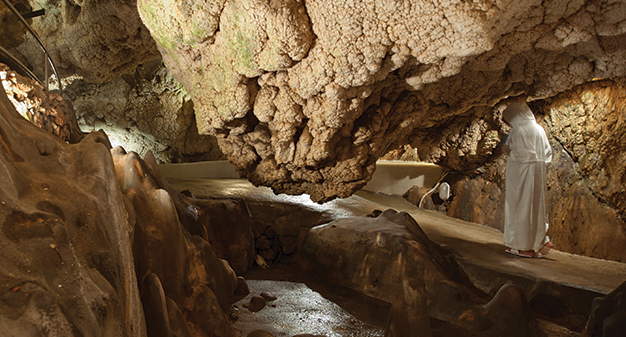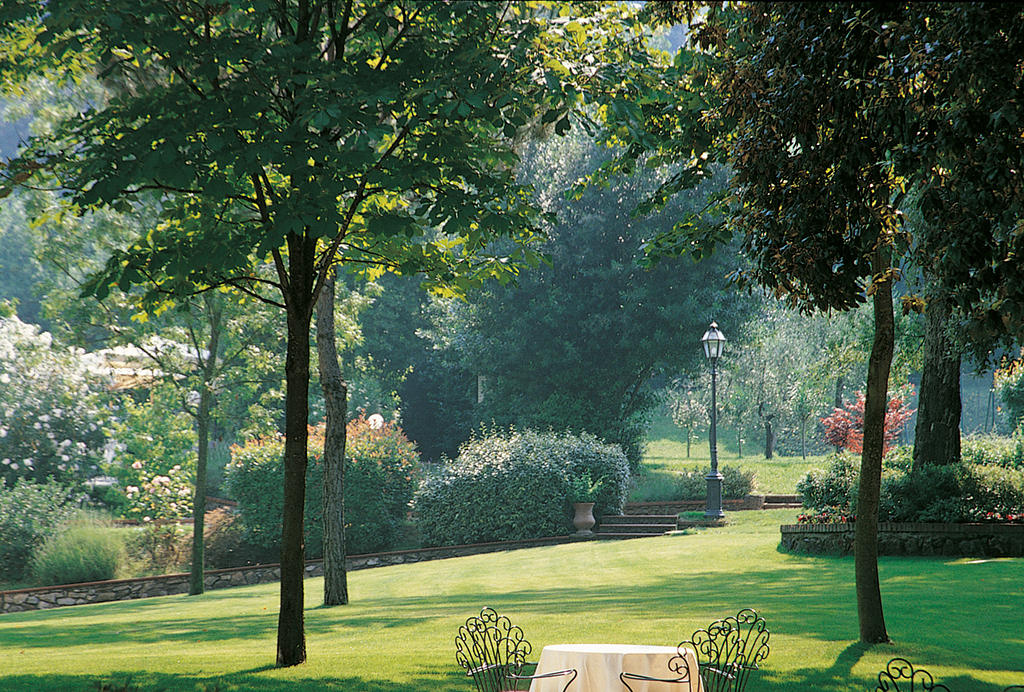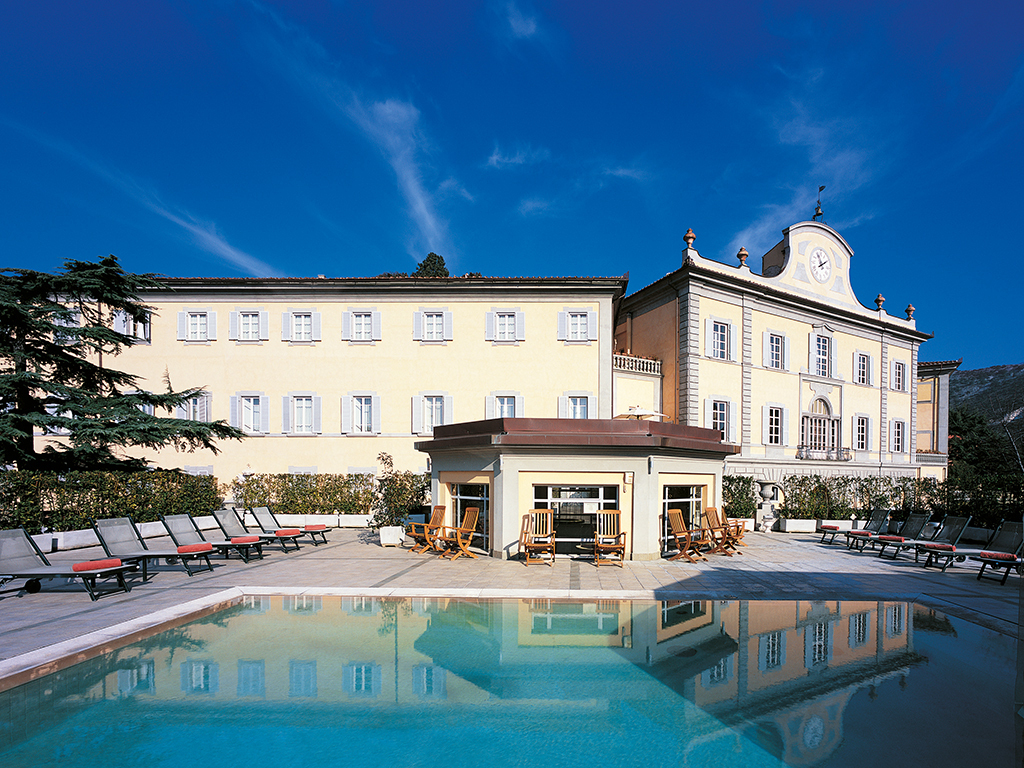For centuries water has been used for its healing properties. The Romans instilled a level of decadence and perhaps even gave spa-ing its name: ‘salus per aquam’. Supreme Spy looks to Italy and two very different interpretations of health through water.
Grotta Giusti is in the Tuscan hills; green landscapes meet pale stone houses meet olive fields. Dating back to the nineteenth-century, the house was first owned by poet Giuseppe Giusti and enough original features remain to picture the satirist composing verses here. The entrance hall sets the scene; high ceilings, dramatic flowers and original art.

The 64 hotel rooms are decorated with emerald green, gold and yellow with dark wooden shutters on the windows. The restaurant has floor to ceiling windows on several sides, flooding the space with Tuscan light. The menu is very inclusive; you can eat a four course meal whether you are vegan, vegetarian, have a gluten allergy, are on a low calorie diet or prefer fish to meat. The bar is decorated with floral frescos paled with age.
Below ground you’ll find something very special - unique even. The hotel is built around an underwater spring, full of mineral water rich in calcium, magnesium and bicarbonate. History has it that in 1849 two farmhands discovered the thermal grotto hidden by a boulder. One was lowered into the dark to find the 130 million year old grotto, full of stalagmites, stalactites and a lake of warm water. In 1853, it was turned into a health experience, one that is still used today.

The 900-metre deep cave is a short descent from the hotel, the heat in the pathway is intense. Our guide stopped us on the journey to carry out breathing exercises inhaling the salt in the air. When we reached the water it was beautifully clear and blue. We climbed down a metal ladder, and into the cooling water – a welcome respite from the heat.
We then clung to the uneven salt rock like tree frogs moving around the cave, alternating arm over arm, swimming underwater to pass jutting rocks. Our guides turned off their torches and it became completely dark, still and quiet. Our guide stood on a large rock and, in turn, held and moved us through the water for a ‘floating experience’. It was otherworldly and deeply de-stressing.
You’ll find more conventional treatments and pools back above ground in the hotel’s spa. Focussed on water and health, the spa has a medical approach to wellbeing; think white minimalist. They use own brand products as well as the equally Italian [comfort zone].
The outside pool is very large at 750m2 with 40 different hydro jets running the length of the pool. There are four circular walled jet areas where many people sat soaking up the sun. We sat and watched the neighbouring hills, revelling in the quiet.

There’s a second quieter pool and a hydro pool just for use by hotel guests. It’s heated to 35 degrees, private and the perfect suntrap. A place to sit and gather your thoughts pre-treatment.
We tried the Detox Body Treatment (60 minutes, €75). In the treatment room I changed into my disposable panties and laid on the bed, feeling rather exposed. I was about to be covered in dark green mud by my therapist Alisandra, but the slightly prudish British person within me screamed with embarrassment!
The mud brought me back into a relaxed state, it was beautifully warm and felt smooth and comforting on my skin. Alisandra applied the wrap from knee to bust, then wrapped me in soft, thin linen.
Next, she cleansed and toned my face and painted a cooling mask onto my skin. I felt warm and cocooned, happily relaxing for twenty minutes while Alisandra left the room. On her return I showered off the mud and I lay back on the bed to have oil massaged onto legs, back, arms and stomach. I felt relaxed but uplifted too and my skin was very soft.

Grotta Gusti made us feel truly invigorated. There is something very special in the natural waters and the resort handles them in a beautiful and accessible way.
Less rural but rather grand is Bagni di Pisa, originally built as a summer residence for the Grand Duke of Tuscany in 1743. In the comune of San Giuliano Terme, between Lucca and Pisa, the hotel looks out over the rolling Tuscan countryside; you might even catch a glimpse of the Tower of Pisa.

The town is steeped in spa history, from the revival of Pisa in 1112 to the Medici family in the 16th Century. Byron, Shelley and the famously extravagant King George IV visited the villas. The Etruscan and Romans used the natural elements from the area; archaeologists found evidence of baths built of the pure white marble quarried nearby.
In 2004, Bagni di Pisa was renovated to its 18th Century glory; you’ll find frescoed ceilings, extraordinarily high ceilings and long marble corridors. A central staircase sweeps up from the reception to the 61 bedrooms. Our suite was quite breath-taking with a four poster-bed, frescos on the ceiling and a decadent bathroom. We were tempted to claim it our own and refuse to leave.
The Dei Lorena restaurant has a full and flexible menu, carefully crafted by the resident dietitian. The restaurant offers, among others, wellness programmes which are low in calories but high in vegetables, fruit and fish. Take your pre-dinner drinks in the Shelley Lounge. Some say the writer had the idea for her Frankenstein character while staying at the resort.

The Levante Spa is at the far end of the hotel and is more compact than the immense Grotta Guisti, its sister hotel at the Italian Hospitality Collection. The spa also uses mineral-rich thermal waters, though in a more personal way. The main thermal pool – the Percorso Bioaquam – is at the centre of the building with a glass roof allowing the sunshine to stream in. At about 8-9 metres long, it’s for bathing rather than swimming lengths. In the Thalaquam there are two smaller pools, one with saltwater and a second with natural water and strong hydro jets. The Salidarium next door is lined with warm salt crystals. On the rootop there’s another thermal pool where you can take a dip in the sunshine.
At Bagni di Pisa, the grotta is an individual experience. The Hammam dei Granduchi is a small natural cave with thermal water trickling in through a waterfall. The water heats the room; breathe in the salt air from the bath dug into the rock. The room seats four, but it would be much more comfortable (and romantic) with two.

The treatments feel much more personal and tailored, too. We tried the Time Massage (50 minutes, €85) and Antioxidant Facial (90 minutes, €125).
Adel was my therapist for the massage – one of the best I have ever had. She started with her hands on my sternum. She asked me to take three deep breaths and each time I breathed out she applied a slow pressure to my chest, slowing my breathing. She used a rich and smooth cream for the massage; stretching, stroking and pummelling my arms, legs and torso. Her hands seemed to know exactly what my body needed, and she checked the pressure and techniques to make sure I wasn’t uncomfortable.
The Antioxidant Facial was equally indulgent with three different masks. My therapist, Miara, cleansed and toned my skin, then brushed on a tingly mask. She cleansed, lightly massaged around my eyes and applied a cooling mask. Then she used a deep cleansing machine in long sweeps over my face. To finish, Miara applied a mud mask and massaged my hands and arms while it set. She then cleansed again and applied a moisturiser. The facial had instantly visible results – my skin felt and looked wonderful – but it was also very relaxing.
Make time after your treatments to head up to the rooftop pool. The scenery is beautiful with views over the town and surrounding hill tops. Drift in the thermal waters, lap up the heat and indulge in salus per aquam.

A three night thermal expereince spa break at Grotta Giusti starts from £475 per person.
A three night thermal experience spa break at Bagni di Pisa starts from £432 per person.
26th August 2016
